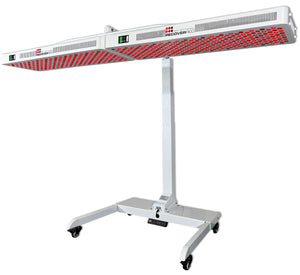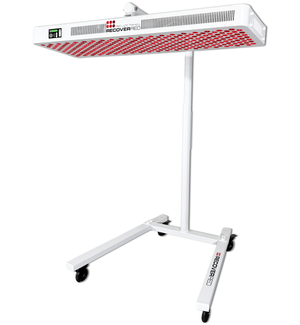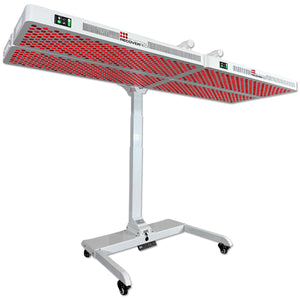As our largest organ, the health of our skin has a direct effect on our overall health and wellness. From regulating body temperature and hormones to aiding our immune system, our skin handles a lot more jobs than we think.
Yet the skin is also prone to problems, and one of the most frustrating for many sufferers is psoriasis. This chronic autoimmune condition typically manifests as itchy, painful patches of skin. Unfortunately, millions of people around the world suffer from this condition, which can be extremely difficult to treat.
Luckily, there have been numerous investigations and studies into the potential of red light treatment for psoriasis. In this article, we’ll discuss the connection between psoriasis, red light therapy, and true relief. Most importantly, we’ll talk about how you can implement phototherapy for psoriasis from the comfort of your own home.
Why Psoriasis is So Difficult to Treat

Psoriasis is an immune-mediated disease. In simple terms, this means that it causes your body’s natural immune system to start overreacting, which can lead to a wide range of different problems. As the immune cells become hyperactive, it forces skin cells to reproduce very quickly, leading to inflamed, scaly, and sometimes painful outbreaks. Though scientists aren’t 100% sure what causes and triggers psoriasis, they do know that a combination of environmental factors and genetics seem to be at work.
The most frustrating part of psoriasis is that it is a chronic disease. Though it’s possible to treat flare-ups, there is no actual “cure” for the condition itself. In many cases, mild psoriasis outbreaks can be treated to some success with oitments and creams, while more severe cases might necessitate pills or injections. As we’ll see in a few moments, there is growing consensus for using light therapy for psoriasis.
But before we get there, let’s look at some of the reasons why treating psoriasis is so difficult.
Complex Immune Response
- Psoriasis involves a complex interplay of immune cells, particularly T-cells, and cytokines, which promote inflammation and rapid skin cell turnover. Targeting this immune response precisely without affecting other immune functions is extremely difficult.Genetic Factors
- Multiple genetic factors contribute to psoriasis, making it hard to develop a one-size-fits-all treatment. The same treatment could impact different people in unique ways based on their genetic makeup.Chronic Nature
- Psoriasis is a lifelong condition with periods of remission and flare-ups. Therefore, managing it requires long-term treatment strategies, which can be difficult to sustain and may lead to varying degrees of effectiveness over time.Variability of Symptoms
- Psoriasis can manifest in different forms and affect many different parts of the body. In many cases, each type and area requires tailored treatment.Comorbidities
- Many individuals with psoriasis also suffer from other conditions. Common examples include psoriatic arthritis, cardiovascular disease, and diabetes. This can complicate the treatment approach and require integrated care plans.Side Effects of Treatments
- Treatments, especially systemic ones like biologics and immunosuppressants, can sometimes have significant side effects. For this reason, balancing efficacy with safety is a major challenge.Treatment Resistance
- Over time, some patients may develop resistance to specific treatments. In many cases, this necessitates a switch to alternative therapies.
What Does Red Light Therapy Do?

Red Light Therapy works by stimulating mitochondria to boost energy production and accelerate cellular repair. This has multiple benefits, including accelerating wound healing, relieving pain, and treating inflammation.
Another crucial component of this process is adenosine triphosphate, or ATP. This molecule is responsible for carrying energy within our cells. By boosting the mitochondria and increasing the production of ATP, Red Light Therapy helps cells heal faster and repair damage more efficiently.
This explanation should make it pretty clear why so many healthcare providers see a connection between red light therapy and psoriasis treatment. This potential is further highlighted by the fact that RLT, while previously available only in clinical settings, is swiftly gaining popularity as a home phototherapy treatment.
Psoriasis and Red Light Therapy
Both research and anecdotal evidence suggest that Red Light Therapy can be a powerful tool in managing psoriasis. For instance, we know that red light therapy can enhance cellular energy production, improve circulation, and modulate the immune response. All of these tend to have a significant impact on the body’s ability to manage the symptoms of psoriasis.
During RLT treatment, the red spectrum 660nm directly affects and energizes the skin's dermis layer, while the infrared spectrum can penetrate deeper, enhancing the red light's effectiveness. Several studies have demonstrated that this can help alleviate the characteristic redness, scaling, and thickness of psoriatic plaques.
By stimulating cellular repair and reducing inflammation, red light therapy has shown the ability to promote the shedding of skin cells and encourage the growth of healthier skin. This often leads to a visible improvement in the appearance of affected areas. Best of all, the non-invasive nature of this therapy makes it an attractive alternative to traditional treatments, which can sometimes carry undesirable side effects.
Common Psoriasis Treatments vs. RLT

In contrast, Red Light Therapy offers an all-natural way to give your cells the energy they need to heal and regenerate. It reduces inflammation, increases blood flow, and reduces scarring, making it an excellent supplemental treatment for psoriasis. More important of all, it’s safe enough to be used multiple times a day, which can be crucial for treating flare-ups.
Though psoriasis patients previously had to consider cost and travel when contemplating RLT treatment, home-based Red Light Therapy devices have completely solved this problem. Having a device at home allows for convenient and consistent treatment, enhancing the overall effectiveness of managing psoriasis. In fact, there are devices for both targeted and full-body sessions, giving the user the power to both treat current outbreaks and help prevent future flare-ups.
Why it’s Important to Avoid Tanning Beds for Psoriasis Treatment
As previously mentioned, tanning beds and RLT therapy are not the same thing. Though both could be technically considered a form of “light therapy,” they serve completely different purposes and utilize different types of light. RLT uses low-level wavelengths of red or near-infrared light, which penetrate the skin to stimulate cellular energy production and enhance tissue repair and regeneration. Tanning beds, on the other hand, use ultraviolet (UV) light to darken the skin. Though this has some rejuvenating effects, it also comes with significant health risks.
One of the key advantages of red light therapy in psoriasis treatment is its safety and non-invasive nature. This is why you see so many RLT services being offered at gyms and spas. You can even get Red light treatment at Planet Fitness through the Planet Fitness Total Body Enhancement system. But while this can be a great way to rejuvenate your skin and muscles after a workout, it’s not the best approach to treating psoriasis. If you search “what is total body enhancement at Planet Fitness,” you’ll quickly realize it’s not a therapy as much as a beauty device.
Rather than attempt to treat your psoriasis in a public, shared space, it’s almost always a better idea to use RLT at home. This convenience not only improves accessibility but also empowers psoriasis sufferers to take an active role in managing their condition, fostering a sense of autonomy and control over their treatment regimen.
At-Home Red Light Therapy for Psoriasis and More
As you can see, treating psoriasis with Red Light Therapy offers numerous benefits. At its heart, it’s a non-invasive, all-natural way to give your cells the energy they need to heal and regenerate. Moreover, getting a device for home use not only helps with psoriasis but also provides a range of other benefits, including minimizing painful inflammation, boosting skin health, and aiding in muscle recovery.
As research continues to shed light on the remarkable potential of Red Light Therapy in alleviating the burdens of psoriasis, this innovative treatment approach offers a glimmer of hope for individuals navigating the challenges of this chronic skin disorder.
With its non-invasive nature, encouraging clinical evidence, and potential integration with existing therapies, red light therapy stands poised as a promising avenue in the quest to improve quality of life for those living with psoriasis.




